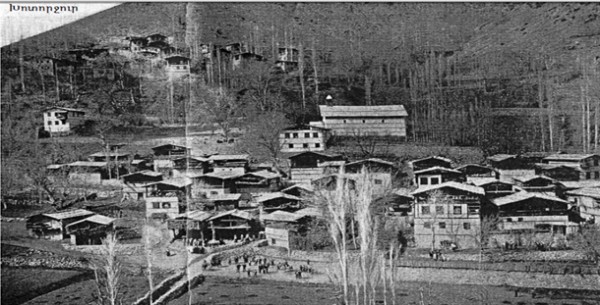22.03.2016

Khotorjur village, which was populated with Armenians, was one of the centers of Kiskim district of the Erzeroum province. The Khotorjur Armenians were Catholic creed (about 7,000), due to which the settlement was called "little Rome".
By the order of Turkish authorities the deportation of Khotorjur and surrounding villages to Mesopotamia took place in May-June 1915. The population, which was divided into five groups, was deported part by part.
All groups of migrants of Khotorjur were subjected to massacres all the way of deportation. Just at the beginning of the way the first group was almost completely destroyed. The corpses were thrown into the river Chorokh by the Turkish and Kurdish slaughterers.
The second group was massacred in a valley on the road between Gasapa and Erznka.
The third group took the way on June 8, 1915, in the route Gasapa-Baberd-Erznka-Kemakh-Malatia (here all men were killed) -Urfa- Aleppo.
Men of the fourth group were killed in mountains on the way to Malatia, it was followed by the massacre of women, old people and children on the bank of the Euphrates River, near the locality Samsat. The regular troops of the Turkish army and Chetes were participating in massacre.
The Genocide survivor Manik Babasyan describes the massacre of women and children from Khotorjur on the bank of the Euphrates River, "The river became the grave for many people. But the awful things were ahead. The cruel gendarmes, who were in front of Euphrates river, noticed that the ship couldn't accept more people, and all who remained were thrown into the water. Women and children were killed one after another with the sword, cane strokes... The caravan of 30-35 thousand people was destroyed, only about 50 people could survive."
The fifth group of deportees was destroyed in Poshin village near the province of Severek of Diyarbakir.
Women from Khotorjur did not denounce their faith on the way to the inevitable death. Survivor Vergine Zarifian writes: "When the Turks and Kurds suggested our women going with them and in that case they will save their life, our women said, ignoring the Turks and Turkishness, "We are ready to die for our nation and holy faith than to marry Turk or Kurd".
From the memoires of honorable Nazlian, who was one of the pastors of Khotorjur, "During this long and hard journey people from Khotorjurt together with their priests were fervent Catholics, paragon of piety. Every day they went to Holy Communion until they were deprived of the liturgy, because of great number of clergy was martyred. And the women, despite all sorts of monstrous behavior against them were simply heroines with their tenacity and patience. When they reached Kemakh-Poghazi they were in a dilemma between falling into the abyss and religious conversion. Then they crossed over themselves and jumped into the river in great numbers".
A part of bulletin, which is dedicated to the Genocide of Khotorjur
" People from Khotorjur remained faithful to their faith and national ideals…. They were always consistent with themselves, they never broke their covenant, never renounced their faith. All the people willingly and consciously went to death.
Reaching from Chorokh to Arabian and Syrian deserts they have shown the supreme example of courage and devotion. Both men and women, elderly and children, clergymen and laymen with the same enthusiasm were preferring death instead of life, exile instead of slavery…. The women's will (form Khotorjur) could not break from hunger and threat. They were killed in mass, were martyred, were jumping into the water with a groups, in exile they preferred poverty, homelessness, hard work, chains, but they didn't obey to executioners even a bit ".
From thousands Armenians of Khotorjur, who were ordered to leave their native settlement, only about hundred survived the Genocide.
The defense of Khotorjur
In February 1916, the Russian troops occupied Khotorjur. The union "Tayk" which was consisted of the people from Khotorjur (about 1,500 people, mainly they were men), who avoided massacres because before the war they left to Caucasus and Russia to work, began to organize and send the detachments of young people to Khotorjur to protect the settlement and to prepare the food with the hope that at least part of deported population would return.
At the beginning of 1918, when the Russian troops withdrew from the Western Armenia, the Turkish army invaded the Armenian provinces.
110 people from Khototrjur, decided to resist and began to prepare for self-defense. Military committee was elected by the head Augustinos Mchanyan. On January 20, 1918, the first attack by Turkish troops lasted for 4 days. Especially fierce battles were being waged in Klakhints square of Khandadzor, where the Turkish troops were defeated and retreated. Later, the center of self-defense moved to a village of Upper Mokhurkut, which had a natural strong location. Resuming the attack, the Turkish army put the artillery in action, as a result of that the condition of besieged people became grave, but, nevertheless, they managed to halt fire. In spite of the heroic and stanch defense, the forces and ammunition of the people from Khotorjur were slowly declining. People from Khotorjur sent a courier to Andranik for help, but they got a rejection. Andranik said, "It is impossible for saving hundred people's life to sacrifice thousand".
The defense of Khotorjur against Turkish forces continued up to May 1918. After knowing that the Turkish troops occupied the Kars and there was no hope for help, the military committee decided to leave out in small groups. The first group managed to reach Ardvin and to cross the Caucasus with great difficulty. The second group was attacked and imprisoned in Trabzon by the Turks (after the defeat of Ottoman empire in WWI they were released).
Nowadays, the survivors of the people from Khotorjur live in Armenia, Tbilisi, Abkhazia, separate families live in the US, Iran, Italy and other places.
Robert Tatoyan





